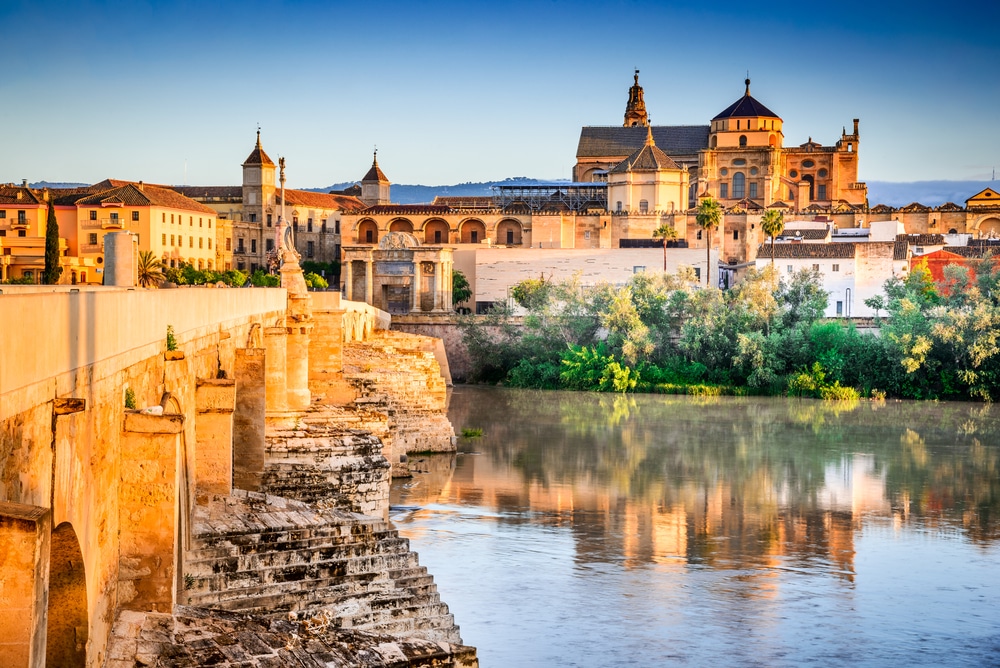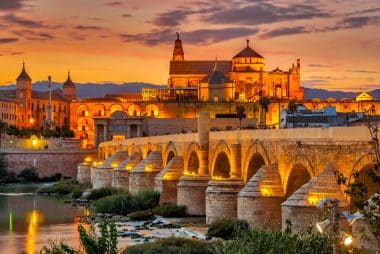
In Córdoba, even the horses have their own cathedral. This is what the Spanish poet Federico García Lorca once claimed. And he is not wrong. Because the third largest city in Andalusia is not stingy with historical monuments. But no wonder, after all, four world cultures lived under the same roofs for centuries in the lively metropolis – the Roman, Christian, Islamic and Jewish. All the more reason for Córdoba to earn its nickname “World Cultural City” or “City of 4 Cultures”.
The most beautiful sights in and around Córdoba
1. The Mezquita Cathedral

With a proud 2,400 square meters, the Mezquita in Córdoba can rightly call itself the largest mosque in the world. Arab conquerors began construction work as early as 787. It was to be a pompous outpost on the Spanish mainland.
From the outside, the Mezquita is restrained. The massive stone walls are simple and unadorned. Hardly anyone suspects such a magnificent interior. 856 red-and-white patterned columns support the sacred building of the Moors. The ornate prayer niches, better known as mihrabs, leave just as much of an impression. Their organic silhouette and glamorous details make them jewels of oriental architecture.
2. The Royal Palace
The Palace of the Kings of Castile is also always worth a visit. The gardens of the Alcázar are particularly inviting. The tall trees and elongated fountains stylishly round off the medieval building.
The Royal Palace of Córdoba has already fulfilled many different functions. Initially it served as a Christian court, later as the seat of the Inquisition court. Most recently, the Spaniards used it as a civil and military prison.
3. Jewish Quarter
Winding alleys, colourful facades, flowers everywhere on the walls – this is exactly how the Jewish Quarter of Córdoba, also known as the “Barrio de la Judería”, presents itself. The heart of the lively district is the synagogue, one of three in the whole of Spain. This is where cultural life takes place. But there is also a lot going on at the Moses Maimonides monument. The statue of the Jewish philosopher, physician and astronomer is well visited all year round.
4. Puente Romana
No bridge leads over the Guadalquivir as impressively as the Puente Romana. 16 stone arches artistically span the largest river in Andalusia. The exact year of construction can no longer be traced. Historians date it to the 1st century under the reign of Emperor Augustus.
Just in time for sunset, the Roman bridge attracts many visitors. Opposite the old town to the Torre de la Calahorra, you have a breathtaking view of the best sides of Córdoba – the Mezquita Cathedral, the river or the Puerta de la Puente.
5. Medina Azahara

Just outside Córdoba is Medina Azahara, about 8 kilometers from the city center. Even from afar, the ruins of the palace city invite you to explore. The typical oriental buildings date back to the year 950 BC, the time of the Islamic occupation of Córdoba. But not only friends of architecture get their money’s worth here. Nature lovers also appreciate the archaeological excavation site. Mighty palm trees and ancient olive trees line the relics steeped in history.
6. The Festival of the Patios of Córdoba
If you travel to Córdoba at the beginning of May, you can’t miss the Festival of the Patios of Córdoba, also known as the Festival of the Courtyards. For 12 days, the locals invite you into their festively decorated courtyards and proudly present their floral splendour. Add to this the rhythmic flamenco sounds on the streets and the delicate scent of jasmine and orange blossom. And those who do a particularly good job will win the prize for the most beautiful flower arrangement of the year at the end.
The 4-culture gastronomy in Córdoba
Not only in the cityscape, but also in the gastronomy of Córdoba, the many cultural influences are clearly noticeable. Be it the Romans, the Phoenicians, the Arabs or the fighters of the Reconquista – they have all left their culinary traces. You can taste the Islamic roots particularly strongly, the many intense spices of oriental cuisine. This ranges from mint and thyme to rosemary and saffron. Typical Moorish vegetables are also served here. Aubergines, spinach, artichokes and bitter orange are still a must in Cordoba cuisine today.
An authentic insight into the Cordobase cuisine is provided by the Victoria Market. It is housed in the oldest hall of the former trade fair in Córdoba. Whether tapas, small main courses or desserts such as gachas de leche or pastel cordobés – there is something for every taste at the colourful stalls. Oysters, squid, salmon, pickles, croquettes, cheeses and Creole pâtés are particularly recommended. This is accompanied by interesting influences from Italian, Mexican, Japanese and Basque cuisine. The Victoria Market is also easy to reach – whether from the historic city center, the AVE train station or the city center.
The best time to visit Córdoba
The Andalusian city cuts a fine figure at any time of the year. Even in autumn and winter, the temperatures are pleasantly mild. If you like to enjoy the Spanish summer warmth to the fullest, you can travel in July or August. If you like it a little cooler, opt for April to June or September to November.

